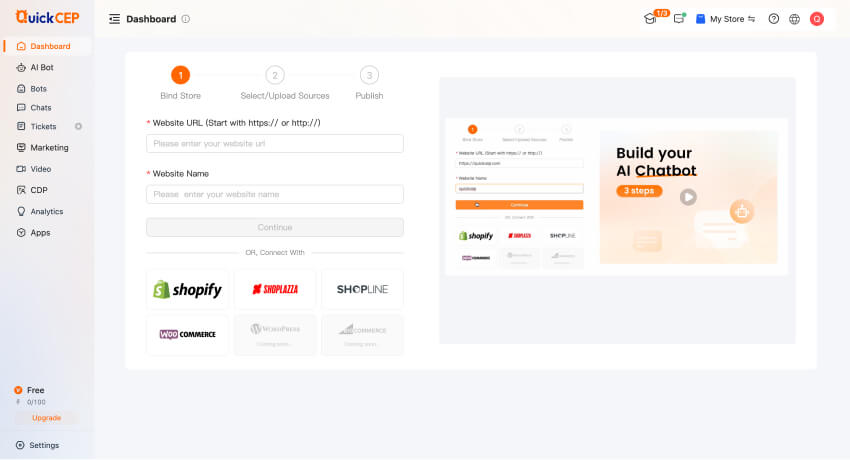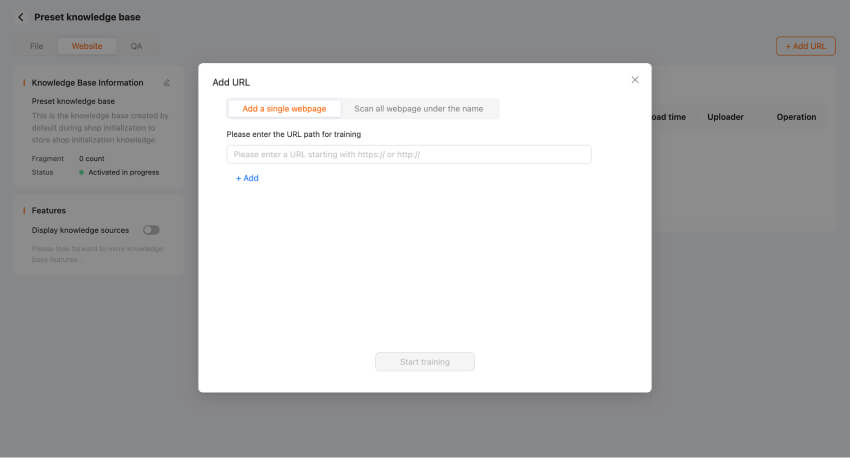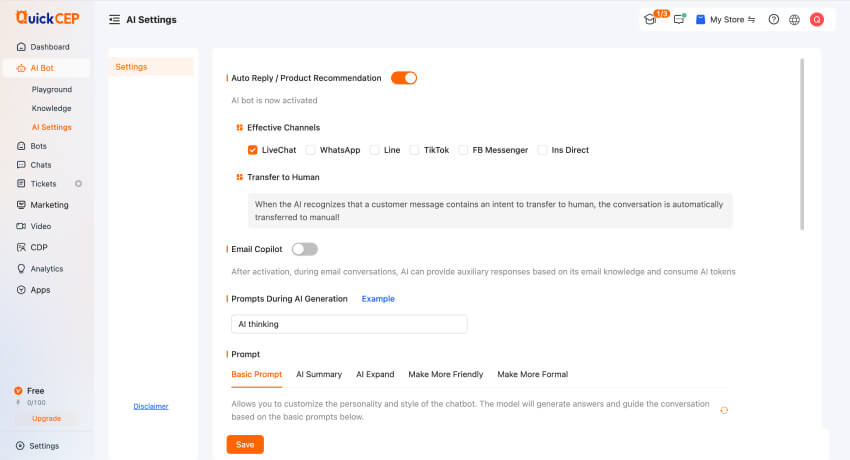Your dream of business growth is now within reach. But there’s a problem – volumes of inbound customer problems are starting to overwhelm you.
Then you thought about this heaven-sent solution — AI chatbots! And you’re right, AI chatbots can resolve customer requests thrice as fast, automatically reducing support workloads.
However, proper training is crucial before implementing chatbots in business. Their accuracy and performance rely on data fed into their system. Otherwise, subpar training processes can lead to AI hallucinations or chatbots telling fictitious or false information.
In this blog, we’ll discuss how to train AI chatbots for customer services to ensure seamless AI-powered support service in your business.
Why Is AI Chatbot Training Relevant?

AI chatbot training is the process of importing data into the chatbot system so it learns how to respond to various customer inquiries. When we say “data”, this could be your internal help documents, web pages, knowledge bases, and other information sources.
Trained chatbots are now prominent in customer service. Around half of US customers have turned to trained AI chatbots for customer support.
Why? Trained chatbots can automatically provide business-specific information to customers.
Say a customer inquires about your new phones for sale. Your trained e-commerce chatbot can provide detailed responses, covering everything from the price, specifications, and features to the warranty and return policies.
More importantly, its training data limits your AI chatbot’s knowledge. The preciseness of their responses depends on the sources’ quality and clarity. Hence, a proper and careful training process is essential. Every source must be verified and proofread to develop a high-performing AI chatbot.
Key Strategies to Train AI Chatbots

For years, chatbots have been developed and trained by coding. This can be a grueling process that takes days to accomplish and requires high-level coding expertise.
Thanks to heaven, we can now train AI chatbots using machine learning, natural language processing, and large language models. Simply import your data sources and AI will automatically “learn” your content.
For successful AI chatbot training, follow these strategies.
1. Select or upload webpages or files that you want the AI to learn from
Say you have an ecommerce shop. You can link your online store’s web pages so AI can crawl and learn its content. Upload also DOC or PDF files containing product description lists, rulebooks, how-to guides, and other pertinent business-specific information. Upon training, your chatbot will answer automatically based on imported content.
2. Use flow templates to configure the bot’s workflow
Flow templates are customizable, ready-made chatbot templates for specific conversation scenarios. For instance, you can use a “new customer discount” bot that automatically offers discount coupons to new site visitors and assists them in their first product purchase.
3. Test and publish your AI chatbots
Upon training, test how your chatbot answers common customer inquiries. Check its response speed and accuracy, making sure that it’s not “hallucinating”. If everything’s well, embed your AI chatbot to your website or connect it with your communication platforms.
4. Review the AI bot’s responses, correct any mistakes, and refine its answers
Go over your chatbot’s conversation with customers. If it provides incorrect or insufficient information to customers, you can manually refine its answers. AI will learn to correct and improve its responses in the future.
5. Analyze the bot reports to understand the bot’s performance
Most chatbots come with AI-powered analytics reports that you can use to enhance their performance. Say your report indicates high agent handoff among chatbot conversations, it’s a sign that your AI chatbot isn’t performing well and needs improvement.
The Role of QuickCEP In AI Chatbot Training
QuickCEP is a platform that trains conversational AI chatbots for e-commerce stores. It offers no-code and simple AI chatbot training as fast as 60 seconds.
With these features, QuickCEP supports seamless chatbot training:
User-friendly interfaces for data collection and annotation
You can easily add data sources using QuickCEP’s intuitive interface. You can easily import files like PDFs or DOCs.




Integration with third-party NLP tools and machine learning platforms.
To ensure effective chatbot training, QuickCEP uses some NLP and machine learning tools. For instance, QuickCEP harnesses Generative Pre-trained transformer (GPT) technology to “learn” large databases and generate responses to customer prompts. As of this writing, QuickCEP uses GPT4.0, OpenAI’s fastest and most advanced AI model that crafts effective and contextual responses.
Testing and performance analytics dashboards to monitor chatbot effectiveness.
Check your AI chatbots’ performance using actionable metrics like the number of bot-engaged sessions, bot interactive conversion, and leads generated with QuickCEP’s all-encompassing performance dashboard.

How To Train AI Chatbots Using QuickCEP
Now that you are familiar with QuickCEP’s key chatbot training features, let’s get to the real action and train your first AI chatbot. Once you get the hang of it, the process becomes fast and simple.
Step 1: Create your QuickCEP account. You can sign up using a Google or Shopify account.


Step 3: To train a new AI chatbot, click Bots in the dashboard menu. You can start uploading file sources like PDF or DOC files by clicking Upload File. You can add at most three files. Make sure that your files contain accurate, up-to-date, and clear content as they serve as your AI chatbot’s “internal knowledge”.


Step 5: Once adding your training sources, click Start Training. QuickCEP will automatically crawl and learn your content to develop an AI chatbot for customer support. The training process usually takes a few seconds only, but it can take a little longer if you add many sources.
Step 6: Upon training, you can test your chatbot by clicking Playground in the dashboard. Enter a sample customer prompt and see how your chatbot will respond. Click Start Chat to ask the AI chatbot.
Look how I test my newly-trained chatbot by asking it about the specific functionality of my product. It seems the bot answered my question well.
In case you are not satisfied with your AI chatbot’s responses, most likely that it has something to do with your training data sources. Click Manage Source in the Playground tab to add or remove data sources. Retrain your chatbot by clicking Start Training.

If everything seems well, proceed to the next step.
Step 7: Customize your chatbot’s essential attributes by clicking Settings in the dashboard. You can adjust your AI chatbot’s background color, font color, avatar, welcome title, welcome message, and more. You can also customize its fallback response or add a human agent transfer button.

Step 8: Once everything is set, publish your AI chatbot to your website via QuickCEP’s dashboard.
Upon deployment of your chatbot, your dashboard will present various essential information including current AI-trained sources and connected channels. You can also quickly change your chatbot’s AI model if you wish (from GPT4 to the lower version GPT3.5).

Alternatively, you can also create a QuickCEP AI chatbot using Flow Templates under the Bots Tab.

The templates already provide scripts and conversation flow that corresponds to your desired chatbot-customer interaction. You can tweak the chatbot’s responses manually or change the button labels.

Note that this process does not involve NLP or deep learning, unlike the training process we shared above. The chatbot only follows the pre-made flow to interact with customers and perform certain actions
Learn No-code AI Chatbot Programming Using QuickCEP
AI chatbots are the game-changers of modern customer service. Gone are the days of sluggish support queues (and frustrated customers) as these chatbots can provide efficient and speedy service in a flash.
Yet, the effectiveness of AI chatbots is only possible by investing in proper training. It ensures that chatbots strictly provide accurate information straight from your business-specific data provided. Using machine learning and NLP, AI chatbots can deliver a conversational and personalized approach to your knowledge to customers, improving customer satisfaction, retention, and loyalty.
A seamless, no-code training process from QuickCEP can help you develop AI-powered chatbots by simply adding your internal knowledge files and web pages. With its playground features, you can verify your trained chatbot’s performance and refine its training data seamlessly.
Explore QuickCEP’s AI-powered customer service solutions for free today.



